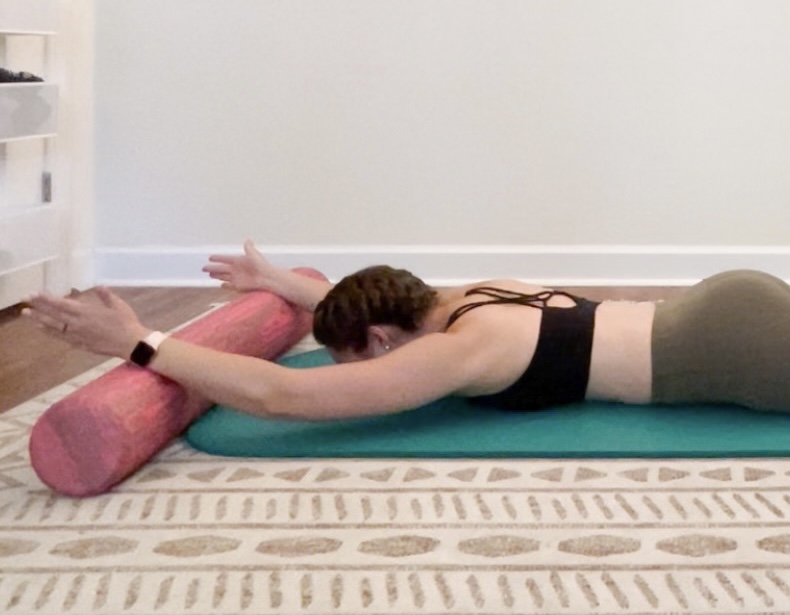Strengthen Your Posterior Chain: Shoulders and Spinal Extensors
Do you know what the word “posterior” means? Maybe you’ve heard a healthcare or movement practitioner talk about your “posterior chain” or “posterior body.”
Posterior refers to the back of the human body, and your posterior chain is simply the group of muscles and bones that make up the back of your body. Unfortunately, many of us don’t strengthen the back of our bodies, and things like sitting in front of a computer all day or bending over to pick things up from the floor can weaken our posterior chains significantly.
But hey- strengthening your posterior chain isn’t all that hard! Posterior strengthening can include your scapula stabilizing muscles, spinal extensors, glutes, and hamstrings. We’ll focus on the first two in this post, but you can read more about your glutes and hamstrings here!
Here are a few of my favorite exercises for strengthening your upper posterior chain.
Note for those who have had spinal fusion surgery: These exercises can be done with a scoliosis spinal fusion (see my notes within the descriptions!), but I recommend trying them with the supervision of an experienced movement practitioner first. Every spinal fusion is different, so you’ll want to enlist the help of a spinal fusion exercise pro to ensure you’re working within a safe and beneficial range of motion for YOUR body.
Strengthening Your Scapula Stabilizers and Spinal Extensors
Shoulder Half T’s
From an all 4’s position, line up your wrists under your shoulders. Lift one arm directly out to the side, as if making the shape of half an uppercase “T.” Focus on contracting the muscles that sit between your shoulder blade and spine on whatever side you’re lifting. Alternate sides, and perform 8-10 reps on each arm.
These can be done with or without hand weights, and help strengthen some of the muscles in your mid and upper back.
Scapular Depression + Baby Swan
Lie on the floor in a prone position (aka, lowered all the way onto your stomach). Rest the pinky finger side of your arms on a foam roller (or the floor), and start by simply sliding your shoulder blades down. Imagine you’re sliding your scapulas into your back pockets).
Then, keeping your scapulas anchored, add the arching up motion (extension). If you have a spinal fusion, skip the extension and simply practice anchoring and releasing your shoulder blades (or work with a movement practitioner who can help you find an appropriate range of motion for your fused spine in this motion).
Reformer Pulling Straps
With one yellow or one blue spring hooked up, lie on the box with your head toward the risers and feet toward the footbar. Scoot forward until your chest is slightly off the box. Pull the the straps straight back along the edge of the frame to work your scapula stabilizers.
Then, pull back the arms and arch up gently through the spine. Imagine threading your sternum (breastbone) through your arms. This can strengthen the spinal extensor muscles in your mid and lower back.
For a long spinal fusion, leave out the extension, or practice it only with an experienced movement professional who can help you find your body’s safe and beneficial range of motion for this move.
**Pro tip: Putting a pillow (or in my case, a rolled up yoga blanket) under your hips can help prevent hyperextension in your lumbar spine, particularly if you have a scoliosis spinal fusion that ends somewhere in your lumbar spine.
Reformer Grasshopper Pushups
With all the springs on, lie on the box with your head toward the risers. Scoot forward until the edge of the box is just below your front hip bones (ASIS), and place your hands under your shoulders on the reformer frame. As you bend your arms and let your chest drop, engage your glutes so that your legs rise. Imagine that your whole body is a seesaw, with your hips as the hinge point.
This one works almost the entire posterior chain! The arm motion helps your scapula stabilizers and triceps, while holding your legs in line with your body fires up your glutes and spinal extensors.
You can also do this without a reformer box- you’ll just have a smaller range of motion, and can only work with one leg elevated at a time. Come to an all 4’s position, then straighten one leg behind you. Lift the leg until it’s in line with your hip, and then let it lift as you drop your chest (you’ll have to hinge from the hips to do this).
Why You Should Strengthen Your Shoulders and Spinal Extensors
For those of us who sit at a computer frequently (which, let’s face it, is most of us these days!), it’s easy to develop a “rounded forward” posture in your upper body. Your pecs become tight, and they pull your shoulders forward into what looks and feels like a permanent slouch.
By strengthening the muscles in your mid back, you can keep your shoulder blades stable, create more openness in your chest, and give yourself a more upright posture and better upper body alignment. Muscles like the lower trapezius, rhomboids, and latissimus dorsi (commonly called your lats) can prevent your shoulders from rounding toward the front of your body.
Need Help? Let’s Work Your Posterior Chain
Working your posterior chain can help with posture, but it can also play an important role in decreasing pain and maintaining good body alignment, particularly for anyone who has a scoliosis spinal fusion. Want more guidance? Let’s work together! Book your private Pilates session today and let’s make sure your posterior chain is off the chain 😉

